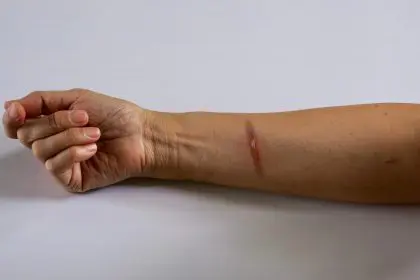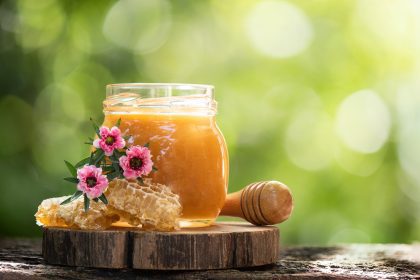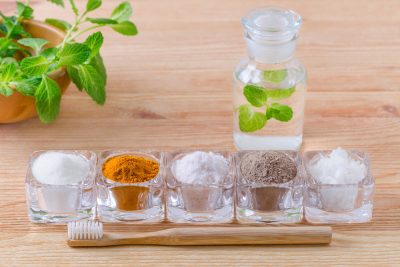The sudden pain of a minor kitchen burn sends most people rushing for commercial burn creams or ointments tucked away in medicine cabinets. Yet these pharmaceutical options, while convenient, often fail to match the healing capabilities of several common ingredients already sitting on kitchen shelves. Recent research reveals that certain culinary staples contain compounds that address multiple healing pathways simultaneously, potentially surpassing conventional medications in both comfort and recovery speed for first-degree and minor second-degree burns.
Raw honey creates the optimal healing environment
Honey stands out as perhaps the most thoroughly studied natural burn remedy, with remarkable properties that create an ideal environment for tissue regeneration. This kitchen staple combines multiple healing mechanisms that work synergistically to speed recovery while minimizing discomfort.
The hygroscopic nature of honey forms the foundation of its effectiveness for burn treatment. This property enables honey to draw fluid from deeper tissues to the wound surface, creating a moist healing environment that promotes faster tissue regeneration while simultaneously cleaning the wound through a gentle osmotic pull that helps remove debris and contaminants.
The natural hydrogen peroxide activity in honey provides antimicrobial protection without the tissue toxicity associated with concentrated hydrogen peroxide solutions. When honey contacts wound fluids, glucose oxidase enzymes produce low, sustained concentrations of hydrogen peroxide that inhibit bacterial growth without damaging healthy tissue or triggering the pain associated with conventional antiseptics.
The acidity of honey, with a pH typically between 3.2 and 4.5, creates unfavorable conditions for bacterial proliferation while supporting wound healing. This mild acidity helps regulate protease activity in the wound, enzymes that in excess can delay healing by breaking down growth factors and extracellular matrix proteins needed for tissue repair.
The viscous physical barrier honey creates protects newly forming skin cells from air exposure that can cause significant pain in burns. This protective coating prevents the nerve endings in damaged skin from direct contact with air while maintaining optimal moisture levels for cell migration and proliferation.
Application technique significantly impacts honey’s effectiveness for burn treatment. Spreading a layer approximately 1/4 inch thick directly onto the cleansed burn and covering with a clean, non-adhesive dressing creates optimal conditions. The covering prevents the honey from being wiped away while still allowing its active compounds to interact with the wound environment.
Important considerations include using only raw, unpasteurized honey, as the heating process in commercial processing destroys many of the enzymes responsible for its antimicrobial and anti-inflammatory effects. While all raw honey offers burn healing benefits, certain varieties like Manuka honey contain additional compounds that enhance their medicinal properties, making them particularly effective for burn treatment.
Aloe vera gel delivers concentrated healing compounds
The clear gel from aloe vera leaves contains an impressive concentration of compounds that support multiple aspects of the burn healing process. This succulent plant, often grown as a houseplant specifically for first aid purposes, provides accessible burn treatment with demonstrated effectiveness.
The glycoproteins in aloe vera help reduce the immediate pain and inflammation of burns by inhibiting the action of thromboxane, a pain-signaling compound produced in injured tissue. This pain-relieving effect often begins within minutes of application, providing comfort comparable to many topical anesthetics without their potential sensitizing effects.
The growth factors abundant in fresh aloe gel, including gibberellins and auxins, directly stimulate the proliferation of new cells and increase collagen synthesis in the healing tissue. This enhanced cell production and structural protein formation contributes to faster wound closure and stronger repaired skin with less scarring potential.
The polysaccharides in aloe create a protective scaffold on the burn surface that maintains optimal moisture while allowing oxygen permeability. This balanced environment prevents both the dehydration that can deepen tissue damage and the excessive moisture that might promote bacterial overgrowth.
The vitamins C and E in aloe gel provide antioxidant protection during the healing process, neutralizing free radicals produced by damaged tissue. This antioxidant activity helps prevent secondary oxidative damage to surrounding healthy cells, potentially limiting the spread of the initial injury.
Harvesting and applying aloe correctly maximizes its burn-healing potential. Selecting a mature leaf (at least two years old) from the outer portion of the plant, slicing it lengthwise, and scooping the clear gel while avoiding the yellow latex layer near the rind provides the most effective preparation. Applying this gel directly to the cleansed burn and allowing it to air dry before covering creates optimal results.
For those without access to a live plant, commercial pure aloe vera gel products can provide similar benefits if they contain high percentages of aloe (ideally 99-100%) without added alcohol, fragrances, or colors that might irritate damaged skin. Refrigerating these products before application adds a cooling effect that further reduces burn discomfort.
Potato provides unexpected burn relief and repair support
Perhaps the most overlooked yet remarkably effective kitchen-based burn treatment comes from the humble potato. This staple root vegetable contains compounds that address multiple aspects of burn healing through mechanisms distinct from conventional medications.
The high moisture content in raw potatoes provides immediate cooling and hydration to burned tissue when applied promptly after injury. This cooling effect helps halt the progression of thermal damage, potentially preventing a minor burn from worsening and reducing the overall healing time required.
The starches in potato create a natural, non-adherent covering that protects exposed nerve endings while maintaining the moisture balance needed for optimal healing. Unlike some commercial non-stick dressings that require painful removal, potato pulp naturally separates from the healing skin as new cells form underneath.
The vitamin C in potatoes supports collagen synthesis, a crucial component of skin repair. This antioxidant also helps neutralize free radicals generated by the burn injury, potentially limiting the zone of damage and supporting more efficient healing.
The alkaloids naturally present in potatoes, particularly in varieties with higher solanine content, demonstrate mild analgesic properties that may contribute to pain reduction when applied topically to burns. These compounds appear to modulate pain signaling through mechanisms distinct from conventional analgesics.
Application technique significantly impacts potato’s effectiveness for burn treatment. Grating a clean, raw potato (with skin removed) creates a pulp with maximum surface area contact. Applying this pulp directly to the burn and allowing it to remain until it naturally dries and separates provides optimal benefit without disrupting newly forming tissue.
For deeper or larger burns, creating a potato poultice by wrapping the grated potato in clean, thin cotton material provides similar benefits with easier application and removal. This method allows the active compounds to make contact with the burn while keeping the potato material from fragmenting into the wound.
Proper assessment determines appropriate home treatment
While these kitchen ingredients often outperform over-the-counter medications for minor burns, proper burn assessment remains essential for determining appropriate treatment. Only first-degree burns (redness, pain, minor swelling) and small second-degree burns (blisters less than 3 inches in diameter) should receive home treatment.
Burns requiring immediate medical attention include those covering areas larger than 3 inches, burns on the face, hands, feet, genitals, or major joints, all third-degree burns (white or charred appearance with reduced pain sensation), chemical burns, electrical burns, and any burns in very young children or elderly individuals.
The initial treatment steps remain identical regardless of which kitchen remedy will be applied. First, remove the heat source and any clothing or jewelry near the burn. Then cool the burn with cool (not cold or icy) running water for 10-15 minutes to halt thermal damage progression. Only after this crucial cooling period should the kitchen remedy be applied to the clean, cooled burn.
Each of these kitchen ingredients provides superior benefit when used early in the burn healing process. Ideally, application should begin within the first hour after cooling the burn, when the inflammatory cascade is still developing and can be most effectively modulated by the bioactive compounds.
Mechanisms of action exceed conventional medications
The superiority of these kitchen ingredients over many commercial preparations stems from their complex composition addressing multiple healing pathways simultaneously. While conventional medications typically target single mechanisms like moisture retention or bacterial inhibition, these natural alternatives provide comprehensive support for the entire healing process.
The anti-inflammatory compounds in these kitchen remedies reduce swelling and pain without the potential side effects of nonsteroidal anti-inflammatory drugs that can sometimes delay wound healing through their effects on prostaglandin production. This gentler anti-inflammatory action reduces discomfort while still allowing the beneficial aspects of inflammation necessary for proper healing.
The antimicrobial properties these ingredients provide occur without contributing to antibiotic resistance or disrupting the skin’s beneficial microbial balance. Unlike broad-spectrum antibiotic ointments that indiscriminately kill beneficial and harmful bacteria, these natural alternatives create environments unfavorable to pathogenic organisms while still permitting the growth of commensal species that support skin health.
The physical protection these remedies offer frequently surpasses commercial options in both comfort and functionality. The natural interfaces they create between damaged tissue and the environment maintain ideal moisture levels while allowing appropriate gas exchange and minimizing pain from exposed nerve endings.
The bioactive compounds in these kitchen ingredients actively participate in the regenerative process rather than merely providing passive protection. Growth factors, enzymes, and nutritive compounds directly support cellular reproduction, migration, and organization during healing, potentially accelerating recovery beyond what passive protection alone could achieve.
Historical usage aligns with modern understanding
These kitchen-based burn treatments connect contemporary research with historical healing practices spanning diverse cultures and time periods. The consistent documentation of these remedies across widely separated geographical regions and historical eras suggests empirical effectiveness that predates modern scientific validation.
Traditional healing systems worldwide have independently discovered these same burn treatments through observation and experimentation. This convergent evolution of medical approaches across different cultures lends additional credibility to their effectiveness, as diverse populations arrived at identical solutions through separate paths of discovery.
The persistence of these remedies through the advent of modern medicine reflects their genuine utility rather than mere cultural tradition. Many pharmaceutical approaches have supplanted traditional remedies when they demonstrate superior effectiveness, yet these particular burn treatments continue seeing use alongside modern options, suggesting competitive or superior efficacy.
The accessibility of these ingredients across economic and geographic barriers has contributed to their enduring usage. Their presence in most households worldwide means effective burn care remains available even in settings where commercial medications prove difficult to obtain due to cost, supply limitations, or geographic isolation.
Practical application guidance ensures optimal results
Creating a home burn care kit containing these ingredients ensures readiness for minor burn emergencies. Storing raw honey in a sealed glass container, maintaining an aloe plant or pure commercial gel, and keeping potatoes on hand provides complete preparation for minor thermal injuries.
Recognizing that different burns might respond better to different remedies allows personalized treatment. Generally, honey performs exceptionally well for burns with any degree of open tissue, aloe provides excellent results for intact but red and painful burns, and potato offers particular benefit when applied immediately after thermal injury occurs.
Understanding that consistent application provides superior results to single treatments guides proper usage. All three remedies work best when reapplied at least 2-3 times daily until healing completes, creating a supportive environment throughout the entire recovery process rather than only initially.
Recognizing potential individual sensitivities ensures safety despite these ingredients’ generally excellent tolerance profile. Performing a patch test on healthy skin before applying to burned tissue provides an extra precaution for those with known sensitivities or allergies to any of these ingredients.
Integration with conventional care enhances outcomes
While these kitchen ingredients often outperform over-the-counter options for minor burns, they complement rather than replace comprehensive burn care principles. Their use alongside proper burn cooling, appropriate wound cleansing, and careful monitoring creates optimal conditions for recovery.
In more significant burns requiring medical attention, these kitchen remedies can still play supporting roles in the recovery process after initial medical treatment. Many healthcare providers acknowledge the benefits of options like medical-grade honey in wound care settings, creating potential integration points between conventional and kitchen-based approaches.
Documentation of response helps identify which remedy works most effectively for individual circumstances. Keeping simple notes on which ingredient provides the fastest pain relief, most comfortable healing experience, and best cosmetic outcome guides future treatment choices for recurring burn situations.
Understanding that different healing phases might benefit from different remedies allows for sequential treatment approaches. For example, potato might provide excellent immediate relief, followed by aloe during the inflammatory phase, and honey during the proliferative phase when new tissue actively forms.















